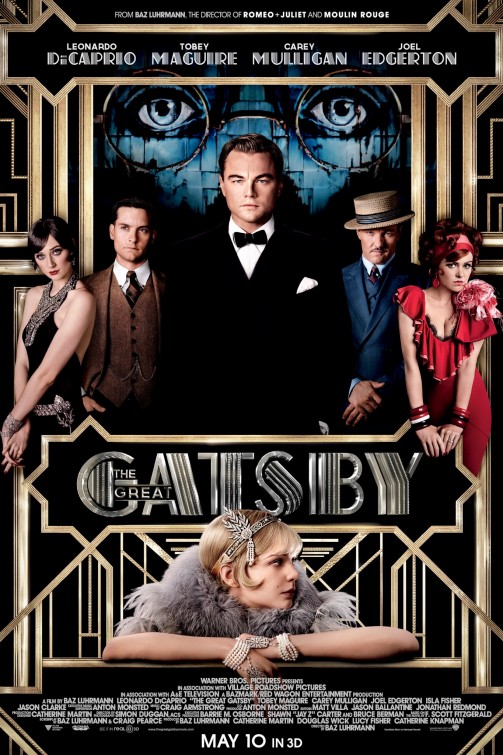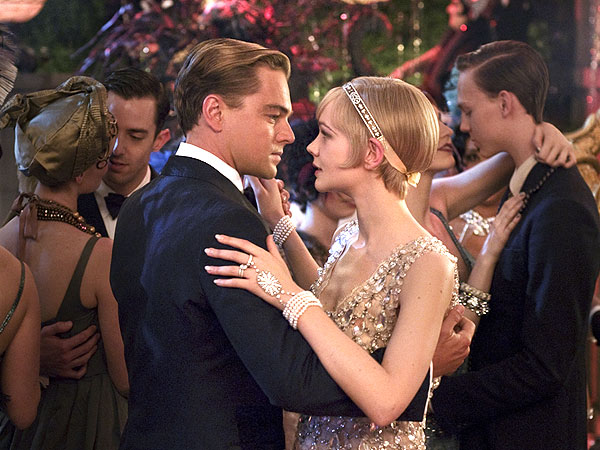Review by Sarah Carter
The Great Gatsby created by Baz Luhrmann in 2013 follows the life of Nick Carraway, played by Tobey Maguire, a young man from Minnesota who moves to New York. Nick has an honest yet virtuous persona, making the party lifestyle of New York a curiosity for him. This curiosity is enhanced when he hears about his neighbour, Jay Gatbsy; a pretentious figure who is famous for his extravagant parties in which the whole city is eligible to attend. The parties revolve around celebrating their glamorous lifestyles and high class with champagne, jazz bands, and spectacular displays of dance, music and swimming. However, despite the extravaganza, not many guests acknowledge Jay Gatsby or who is, and many myths exist around the character.
The Cast include Leonardo DiCaprio, who plays Jay Gatsby. DiCaprio accomplishes a legitimate character of Jay Gatsby, a mysterious character who lives in a large mansion in West Egg, Long Island. Jay Gatsby is a dishonest man, ashamed of his past. He often lies in order to disguise his true self and past, claiming to have been educated at Oxford and son of a wealthy family, although his Mother and Father have both died. The film effectuates mystery, as the audience is left guessing who Jay Gatsby is, why he is so obsessed with Daisy, and how he has accomplished this lavish lifestyle. As the extravagant parties continue to take place every Saturday, Nick’s curiosity is heightened, until he eventually forms a close bond with Gatsby, and discovers that he is from a poor family from North Dakota, and after working for a millionaire, he strived for wealth. After meeting Daisy in Louisville, he became infatuated with her, and made a fortune by criminal activity just so that she would notice him.
 This mysterious characterization portrayed by DiCaprio is executed brilliantly. The façade of his outer character as Gatsby is a man of little words, and portrayed to be isolated and obscure, despite his wealth and parties which attracts many people to his existence. However, Gatsby is also depicted as a confident man, who dwells in the lies that he tells people.
This mysterious characterization portrayed by DiCaprio is executed brilliantly. The façade of his outer character as Gatsby is a man of little words, and portrayed to be isolated and obscure, despite his wealth and parties which attracts many people to his existence. However, Gatsby is also depicted as a confident man, who dwells in the lies that he tells people. As well as this, the growing independence of women is conveyed by Carey Mulligan. At the beginning, Daisy is portrayed to be a woman who is helpless and dependent on her husband. Nevertheless, Daisy gains more and more power throughout the film, and we receive more of an insight into her real persona. She is tempted to run away, and secretly visits Gatsby at his house despite her husband’s disapproval and contempt. At one point, she has both Gatsby and Tom in her grasp, and both of them are determined to win her over. At the end of the film, Mulligan’s acting represents Daisy as her own person, yet shallow as she appears to have no inhibitions or underlying guilt towards the death of Gatsby.
In addition, the Roaring 20’s is portrayed by the Jazz, extravagant parties, flamboyant cars, houses and clothes, and the need for all the characters to make a good impression in their social situation. The Great Gatsby captures with excellence the 1920’s era, with conventions such as The Jazz Age, flapper dresses and dapper suits. These conventions are incorporated with the reality of 1920’s America in order to give an authentic outlook on this era. The economic state of America in the 1920’s, as it was a time where the country maintained a lot of supremacy and capacity; and in the near future was going to become one of the world’s only superpower country. However, this ideal of everyone equally living in wealth was unrealistic, and there were many pockets of people who lived their live in poverty and were obliged to work consistently. The split between those whose lives were adorned with elegance and luxury and those who lived in sheer poverty is conveyed by Baz Luhrmann, as we see the difference of wealth when Gatsby, Daisy, Tom, Nick and Jordan all visit New York, and have to cross the industrial part of New York, a pocket of poverty. The inhabitants are shown to work continuously in underprivileged conditions and with a poor quality of life.
As well as this, some scenes do not appear genuine, and somewhat overly-edited. The computer trickery, which despite aids to conceive realistically the what many scenes would have actually looked like during this era, is overpowering and makes the film appear more like a cartoon than a film telling the tragic story of a man’s life before and after his death. In fact, it appears that most scenes have taken place with the cast of actors and a few extravagant props such as cars in front of a green screen.
In conclusion, Baz Lurhmann’s film edition of the novel captures brilliantly the 1920’s lifestyle and the significant symbols of love, culture and injustice. Despite this, at some points the film fails to acquire some of the foremost themes which allow the novel to be a classic and a realistic insight into the life of 1920’s America. This leads me, as the audience, to believe that we are still yet waiting for a film edition of the novel in the future which incorporates all of the primary themes in order to create a film of mystery, love and the sore reality of an age which is imperfect and maintains injustice which is portrayed to ideal, upbeat and pleasant.


